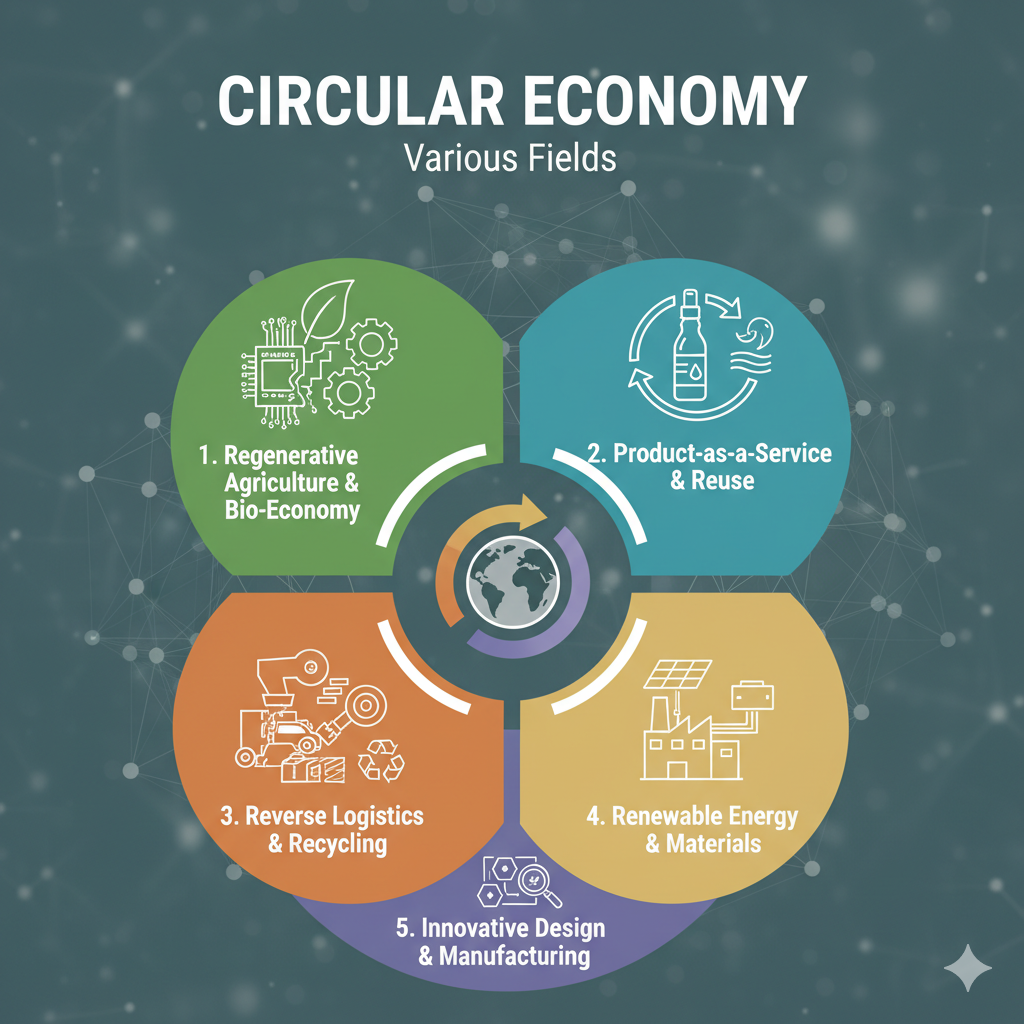The circular economy is a transformative model that aims to redesign the global approach to resource use, production, and consumption by emphasizing sustainable practices and minimizing waste across multiple fields and sectors. It offers innovative solutions for environmental challenges through strategies like reducing, reusing, and recycling, empowering diverse industries to achieve sustainable growth. This article outlines the various fields where circular economy principles are actively applied, supported by references and examples from leading organizations.wikipedia+1
Overview: Defining the Circular Economy
The circular economy diverges from the traditional linear “take, make, dispose” system, focusing instead on maintaining products, materials, and resources in circulation for as long as possible. Central principles include reducing resource consumption, reusing products, and recycling materials to prevent waste from entering landfills and regenerate natural systems.ellenmacarthurfoundation+2
Key Sectors in the Circular Economy
1. Fashion and Textiles
The fashion industry has taken significant strides in adopting circular economy practices by promoting sustainable designs and facilitating reuse and recycling programs. Notable examples include initiatives by Patagonia’s Worn Wear and H&M’s garment collecting programs, which extend product lifecycles through repair and recycling of textiles, reducing the environmental impact of clothing waste.boell
2. Electronics and E-Waste Management
Electronics manufacturers are applying circular principles to tackle e-waste challenges. For instance, Apple’s technology enables disassembly and recovery of valuable materials from devices for recycling, while Dell’s closed-loop recycling system transforms plastics from old computers into new products, lowering the demand for virgin resources and minimizing pollution.boell
3. Food System and Biomass
Circular practices in the food sector focus on reducing waste, optimizing resource use, and promoting sustainable packaging. Programs like Loop by TerraCycle use reusable containers, while many supermarkets donate unsold edible food to rescue organizations, curbing food loss and enhancing community well-being.boell
4. Built Environment
The built environment encompasses construction, real estate, and infrastructure. Circular economy principles in this field promote modular construction, repair, and reuse of buildings and materials, maximizing resource efficiency and minimizing demolition waste. The use of reclaimed materials and eco-designs further supports sustainability and resilience.circularcityfundingguide
5. Consumer Goods
Circular economy models are transforming the consumption of everyday goods by enabling resale, refurbishment, repair services, and extended warranties, all aimed at prolonging product use and closing material loops. Innovative models such as rental and sharing services in the electronics, clothing, and furniture markets exemplify these changes.wikipedia+1
6. Manufacturing and Industrial Symbiosis
Industrial sectors leverage circularity by converting waste streams from one process into inputs for another, creating networks of “industrial symbiosis”. Manufacturing processes are redesigned for resource efficiency and recycling, significantly reducing waste and emissions.wikipedia
7. Energy and Renewables
Transitioning to renewable energy sources and recovering waste energy are core to circular economy strategies in the energy sector. By focusing on sustainability and closed-loop energy cycles, companies reduce reliance on fossil fuels and improve ecological outcomes.allthingssupplychain
8. Waste Management
Circular waste management extends beyond recycling to include composting, refurbishment, and landfill minimization. Efficient local systems and regenerative approaches create value from waste streams and support the broader goal of resource conservation.circularcityfundingguide+1
9. Digital Economy and Smart Solutions
Digital technologies such as artificial intelligence, blockchain, and big data play a vital role in accelerating circular economy adoption. They optimize resource tracking, enable innovative business models, and facilitate more efficient recycling and reuse processes.wikipedia
The Impact and Future of Circular Practices
Circular economy strategies offer multi-dimensional benefits, including resource conservation, economic resilience, job creation, and reduced carbon emissions. Forward-looking sectors demonstrate that adopting circular models leads to tangible environmental, social, and economic advantages, paving the way for a sustainable future that integrates innovation with stewardship.boell+1
References
-
“Circular Economy: Principles, Benefits, and Applications,” Heinrich Böll Foundation, 2024.boell
-
“Circular economy,” Wikipedia, 2023.wikipedia
-
“Circular sectors,” Circular City Funding Guide, 2020.circularcityfundingguide
-
“Six Industries Merging Circular Economy with Supply Chain,” All Things Supply Chain, 2024.allthingssupplychain
-
Ellen MacArthur Foundation, Circular Economy Overview, 2020.ellenmacarthurfoundation
This overview highlights the breadth of fields where circular economy practices are reshaping industries, driving innovation, and addressing pressing environmental challenges through sustainable resource management.circularcityfundingguide+2
References
- https://en.wikipedia.org/wiki/Circular_economy
- https://il.boell.org/en/2024/03/09/understanding-circular-economy-principles-benefits-and-applications
- https://www.ellenmacarthurfoundation.org/topics/circular-economy-introduction/overview
- https://www.circularcityfundingguide.eu/circular-sectors/
- https://www.allthingssupplychain.com/six-industries-that-can-merge-circular-economic-practices-with-supply-chain-management/
- https://www.europarl.europa.eu/topics/en/article/20151201STO05603/circular-economy-definition-importance-and-benefits
- https://climatepromise.undp.org/news-and-stories/what-is-circular-economy-and-how-it-helps-fight-climate-change
- https://ciiwaste2worth.com/DEMO4R/pdf/report/CII%20NCEF%20Edition%202.pdf
- https://www.sciencedirect.com/science/article/pii/S2666412721000167
- https://www.sciencedirect.com/science/article/pii/S0921344925001971

